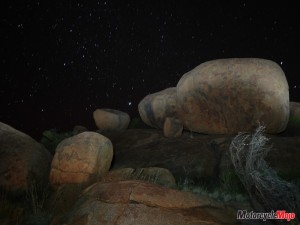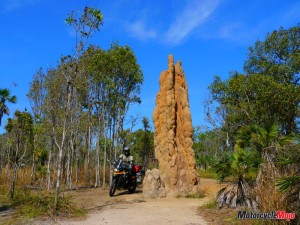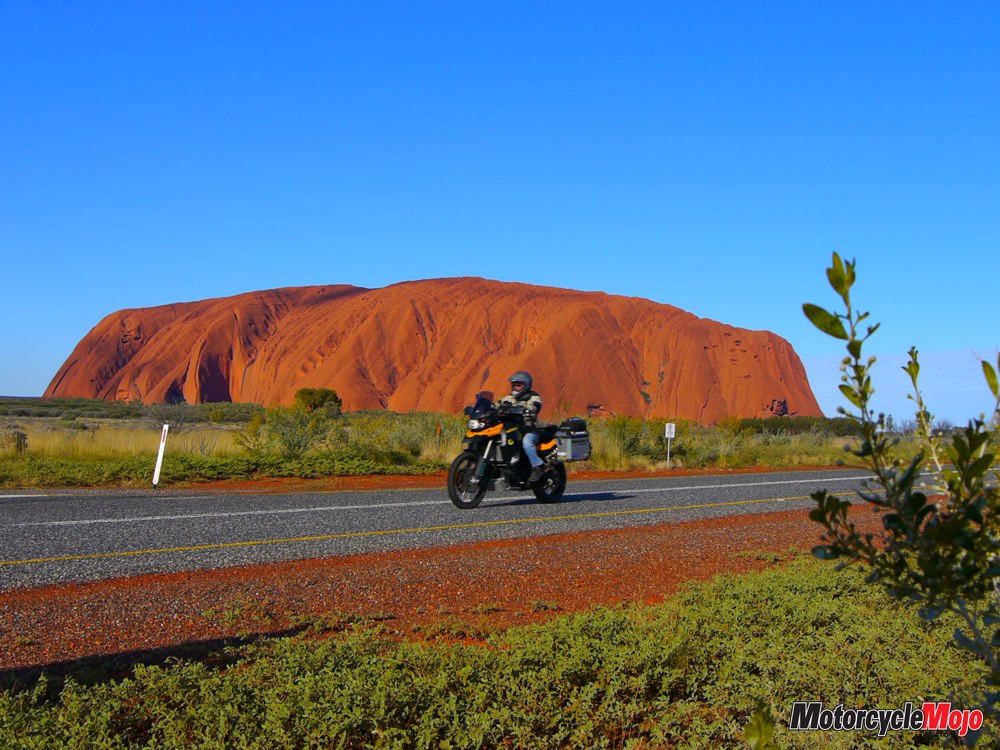Australia’s outback is synonymous with red earth, isolation and calm. The towns are hundreds of kilometres apart, and there are cattle stations in between as big as entire states. It’s a place not to miss during a trip around the world.
The most difficult part of a trip through the Australian outback is to find the beginning. If you ask ten Australians where the outback starts, you’ll probably get ten different answers. In its most basic description, the outback is just where nothing else is – somewhere out there in the bush. Almost all of the Australian states have their own piece of the outback, but for us, the Northern Territory became the incarnation of red earth and loneliness.
South is the only direction to leave Darwin. The Stuart Highway is the main stretch of asphalt that connects everything. Nevertheless, there are plenty of opportunities to get off the highway and explore, so it pays to keep your eyes open.
During our couple of months in Australia, many Aussies recommended that we visit the Litchfield National Park. It’s smaller than its more famous neighbour, Kakadu National Park, but not less beautiful.
The summer has just passed and with it the violent, monsoon-like rains, leaving considerable damage and causing some tracks in Litchfield National Park to be closed. Surprisingly, the termite mounds survived and are overwhelming in size. Dwarfing our motorcycles, it’s incredible to see the huge structures these tiny insects are able to build.
 Our next stop is the beautiful Wangi Falls, which flow into a large natural pool.
Our next stop is the beautiful Wangi Falls, which flow into a large natural pool.
We pitch our tent on the adjacent campground and start to explore the area surrounding the falls. A park ranger tells us that the natural pools are closed to swimming due to saltwater crocodiles, which came upstream during the flooding. In the last couple of weeks they have caught and relocated eight crocs, but there are still many more.
After a peaceful night in the park, we pack our bikes and get back on the Stuart Highway, heading south for almost 300 km until we arrive in the small town of Mataranka. This little dot on the map, with only a few gas stations, has more to offer than we thought at first sight. The secret is hidden behind the turnoff from the highway leading to Bitter Springs.
A small walking trail leads us through palms and eucalyptus trees to the crystal-clear blue water of the springs, which welcomes visitors with a steady temperature of 34°C. We stay longer than planned and decide spontaneously to set up our tent in the adjacent park. We are just finished and lighting our fuel stove to make coffee when a few other campers show up to have a look at our two bikes. The questions are mostly the same – what kind of bikes are they, where are you from and where are you going? Only a few guys recognize our BMW 800 GSs at first sight. We welcome the questions, as it’s always a fun opportunity to converse with the communicative Aussies.
As beautiful as the outback is, the ugly part of each day arrives as the sun begins to set, and the clouds of mosquitos appear. Completely unaffected by our insect repellent, they even sting through our jeans, forcing us into the tent.
 The next morning, we backtrack to the Stuart Highway from this dead-end road. Due to the long rainy season, a layer of algae covers the washouts in the road, which makes each crossing very slippery. Shortly after our start this morning, we follow one of the many signs along the Stuart Highway to a historical Second World War site. The dirt road leads us several kilometres into the bush to an abandoned airstrip. The potholes on the road are filled with a fine red dust called bulldust, and the soft shoulder is more or less a big sandbox. Although the rear tires are almost squared, the heavily loaded GSs dig their way through the track successfully.
The next morning, we backtrack to the Stuart Highway from this dead-end road. Due to the long rainy season, a layer of algae covers the washouts in the road, which makes each crossing very slippery. Shortly after our start this morning, we follow one of the many signs along the Stuart Highway to a historical Second World War site. The dirt road leads us several kilometres into the bush to an abandoned airstrip. The potholes on the road are filled with a fine red dust called bulldust, and the soft shoulder is more or less a big sandbox. Although the rear tires are almost squared, the heavily loaded GSs dig their way through the track successfully.
Back on the highway, the monotonous journey possesses something meditative: trees to your right, trees to your left and a road in between, with virtually no traffic. Should two travellers meet, however, the hand is raised joyfully to greet; another obvious sign that you’re in the outback. The silence and loneliness are ever present, but these are easily forgotten thanks to the stunning views of the outback as it spreads out in front with its ineffable size. The play of colour is overwhelming, with the trees and the amazing red earth enhanced by a clear blue sky.
The only sign of humanity, other than the odd traveller, are people at the roadhouses that are spaced about every 200 km. All of the roadhouses provide fuel, basic groceries and food. It’s also a good chance to have a chat with fellow tourists.
On recommendation from other travellers, we stop at a legendary roadhouse in Daily Waters. To our surprise, while parked at the fuel pump we hear a familiar engine sound – and another 800 GS stops behind us. Louis is from Melbourne and on his way south, too. A friend of his is one day ahead, and they intend to meet again in Alice Springs, Northern Territory. The three of us enjoy a late afternoon snack and plenty of conversation about the difficulty of getting new tires in the outback, something we have to consider shortly.
Louis leaves in a panic upon seeing the time. “You must reach your destination before dark,” he said. “At sunset, the Australian wildlife claims the highway for itself. And a collision with a kangaroo may end badly on a bike.”
We ride directly towards a bushfire producing a dark cloud of smoke, which moves across the highway. A group of eagles circles overhead, looking for easy prey. Each wind gust kindles the fire, and it finally moves north, leaving behind a narrow strip of charred earth that will be full of fresh vegetation in a few weeks. At our Tennant Creek campsite, we investigate a campfire not far away from our tent. That’s where we meet Jimmy Hooker. He’s quite a character. He tells how he grew up on a remote cattle station on the border to Queensland, and decided to live in the bush after he finished the very basic “School of the Air.” He tells us with a mischievous, toothless grin that he survived the outback by eating road kill. Some laugh, others are shocked. What none of the bystanders yet know is that he is cooking a kangaroo tail wrapped in tinfoil in the fire – a traditional food of the Aborigines. This, of course, will be sampled by everyone around the fire once it is revealed. What a long and interesting evening. Alice Springs is only 500 km distant, but on the way is the Devils Marbles Conservation Reserve. The area is a sacred Aboriginal site and encloses thousands of bright, round granite rocks. Although we have only ridden 100 km today, we decide to stay. Just as we finish setting up camp, a ranger informs us of the dingos that inhabit this area. He advises us not to leave anything out, because these wild dogs simply pick up everything. Later, from the dim light of our campfire we can see them sneaking over the rocks.
Our first task in Alice Springs is to organize new rear tires for the bikes. The prices in this area are expensive, but the guys who run the only two shops in town know that whoever is asking for tires has no choice. Grudgingly, we pay the price, which is just as much as we paid for a whole set of tires only two months ago in Cairns, Queensland. After leaving the shop, we start exploring more of this remote city. We hope to learn something about the Aborigines, and we get a tip that we can meet native Australians from the neighbouring communities at the Lutheran church on Sunday. To be honest, it’s been a while since we’ve been to a church, but we don’t want to miss this opportunity. Pastor Dave, who also rides a motorcycle, gives us a friendly welcome. We enjoyed interacting with the Aborigines, but it seems most of the questions and answers are about our bikes. We have a special opportunity to explore living and working at Umbearra Station, a remote cattle station that requires 300 km of highway travel and then 100 km on dirt roads to get there. The highway south isn’t very exciting, but there’s more traffic than we are used to.
A lot of tourists make a day trip from Alice Springs to see the famous Uluru, formerly known as Ayers Rock. The last 100 km of gravel road is pretty well maintained, but suddenly, “floodway” signs appear. We don’t pay much attention to them as the creeks are now dry, but where the water once flowed, there’s deep sand. As we continue, the crossings get longer and the sand gets deeper. We have our final wake-up call at 80 km/h when the first bike loses control and hits the ground, sliding along the gravel. One of the panniers rips off and empties itself all over the road. We are lucky that neither of us got hurt. We get the GS back on the tires and determine that we can fix the broken pannier during the next few weeks on the cattle station. We still have about 80 km to travel, and we’re going much slower now as we cross more floodways and much more deep sand. It’s almost dark when we finally make it to the homestead, and after a warm welcome and a delicious dinner we are totally exhausted. Even riding cautiously, we have to pick up the bikes four times during the ride. The next day, we start our new careers as WWOOFers (Willing Workers On Organic Farms).
We are working on the station for accommodation and food, and have the great opportunity to experience the real Australian outback lifestyle. It’s a short 120 km ride to the next neighbour, and the only company the farmers usually have are 6000 head of Red Angus cattle. The station has its own garbage dump, and the postman comes once per week by plane. Since Alice Springs is an 800 km round trip, the pantry is stocked up with groceries every six weeks. There isn’t any electricity, so the generator runs between 6 a.m. and 11 p.m. It’s a special kind of lifestyle – love it or hate it. We love it – especially the nights when the generator is shut down. We’ve never heard a silence like this before, and we’ve never ever seen a sky full of stars like in those nights in the outback. It’s a unique experience, which we’ll never forget. The most famous part of the outback is Uluru, aka Ayers Rock. It’s just a 400 km ride from Umbearra Station to this special monolith. We’ve heard so many different opinions, ranging from “it’s just a rock in the middle of nowhere” to “it’s the most beautiful and magical rock in the world.” We had to see it for ourselves.
The moment when we ride our bikes through the National Park and round a curve to see Uluru for the first time is absolutely breathtaking. It gives us goose bumps to stand in front of this massive rock, which is the only elevation as far the eye can see in all directions. Due to the heavy rain in the past season, the desert is covered by lush green vegetation, which is a beautiful contrast to the red sand. Uluru is a sacred place for the Aborigines, and they ask visitors not to climb it. As law does not prohibit it, many tourists don’t pay attention to the signs and climb it anyway. Instead, we put on our hiking boots and go for an 11 km walk on the trail that circles the monolith. Every kilometre gives us a different view, and we feel our walking experience is more satisfying than simply standing on top of Uluru.
Our next destination is the town of Coober Pedy, in the middle of the Australian state of South Australia. Ross, an acquaintance from the cattle station, invited us to stay at his place when we came through. Unfortunately, the rear-wheel bearings on one of the bikes are causing us trouble, and it seems we’re not going to make it that far. We get stuck at a roadhouse still 240 km away from Ross. We call him and tell him we’ll be delayed, but what seems to be a problem for us isn’t a problem for an Aussie. Three hours later, Ross shows up, towing a trailer to load up the bike. We then have the unique opportunity to stay in a dugout, a type of house particular to Coober Pedy. As it’s very hot in summer and pretty cold in winter, people started to build their homes into the hillsides of the area. You don’t get a lot of daylight inside, but the temperature is constant year round, so air conditioning and heating are not needed. The nearest BMW dealer is 1500 km away, and they tell us it will take about five days to get the bearings shipped. Luckily, Ross is a retired engineer. He encourages us to take everything apart and look for the spare part in town. We would never have thought that we might get a bearing in one of the local tire shops, but they had everything we needed in stock, and much cheaper than BMW. Three hours later, the bike is fixed. We now have some time for sightseeing with our private tour guide. Coober Pedy is famous for its opals, which attract hundreds of people to dig for these colourful gems.
The city was also used as a film set for many Hollywood productions, such as Mad Max, and many of the props have been discarded and left behind. We prepare our bikes to head south early in the morning. Our planned destination is through William Creek to the Oodnadatta Track and Lake Eyre. The dark clouds on the horizon prompt Ross to looks at the forecast; he warns us that it might not be a good idea to go there tomorrow. They expect heavy rains. The road is known for its flooding and might get closed for days. After some deliberation, we listen to reason and head south on the Stuart Highway to Port Augusta. Ross is correct. The government website keeps posting road closures day after day. We would have been stuck for days in flood areas. The rain is still persistent in that area after a couple of days, so instead, we head north to the Flinders Ranges. It is a clear blue sky and the sun is shining, but the temperature is only 6°C. We stop for a break to warm up in the sun as a truck covered in mud stops beside us. The driver tells us it is still too wet and muddy, and there would be no way to get through this dirt road with our heavy bikes. Foiled again. We have experienced a very wet year for the driest continent of the world, and although it is disappointing, it makes no sense to go on. We have to admit that our outback adventure has to come to an end. It has been a wonderful adventure, but it is time to move on to another country.














































